Shaquem Griffin’s Success Is About Design As Much as Desire

ORLANDO — Shaquem Griffin’s story has been positioned over the last eight months or so as one of perseverance, mental strength and hard work.
I learned a few weeks back that there’s a lot more to it than that.
My idea was to take a different approach to the UCF linebacker. Most football fans know the outline of his amazing story by now: Griffin was born with amniotic band syndrome, had his left hand amputated at age 4, and, despite that, grew into a two-time All-AAC selection and 2017 second-team All-America at a position where players use their hands as tools on just about every play.
My idea was to go from the what of the Shaquem Griffin story to how he got to this point as a player. I haven’t really been in a three-point stance since my senior year in high school (my 20th anniversary is this year), and I was never fast enough to turn the corner with the ball in my hands. But I figured the best way to learn how Griffin has made this amazing story come true was to actually see it for myself. So two weeks ago in Orlando I lumbered out onto the UCF practice field and acted as Griffin’s dummy as he showed me the techniques he’s developed, given his circumstances, to turn himself into this year’s most remarkable draft prospect.
My biggest takeaway, by far, was how Griffin doesn’t just get it done with guts and guile. He wouldn’t be close to where he is now—expected to being taken somewhere in the middle rounds of the 2018 NFL draft—without encyclopedic knowledge of how football works, and how he can make it work for him.
No doubt about it, Griffin has that, which gives him a chance in the NFL.
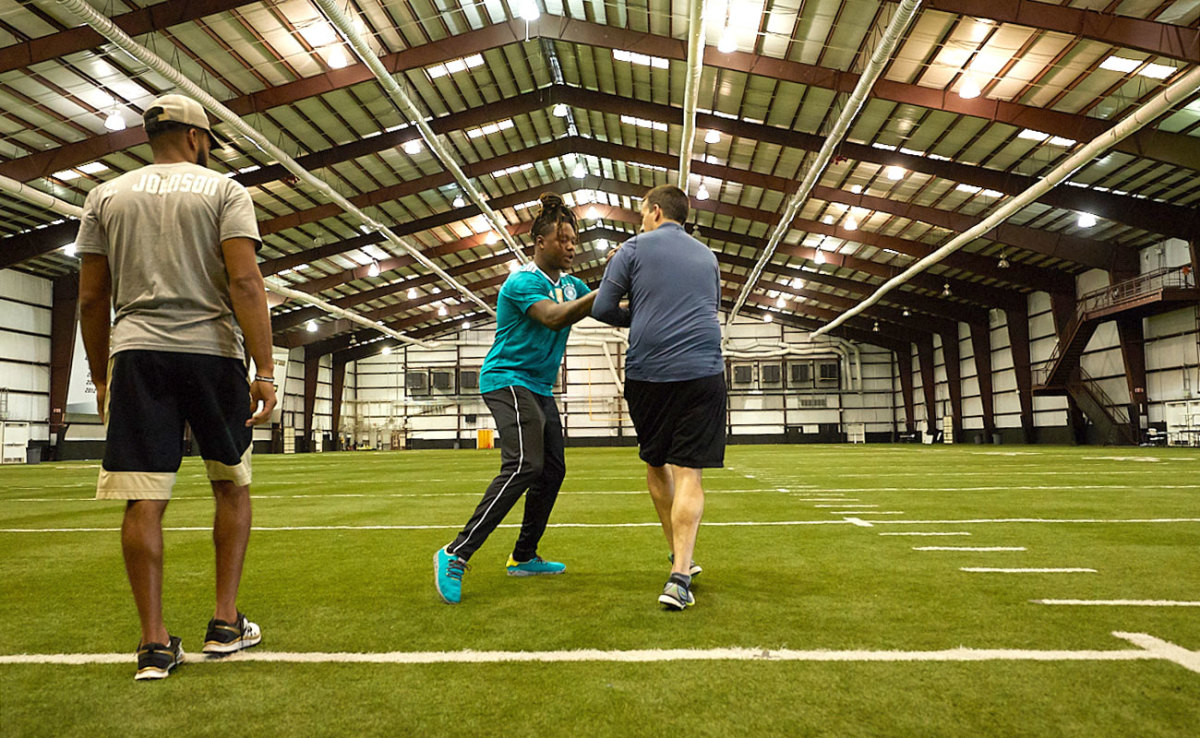
“Football’s a leverage game,” he said as we went through how he’d block a rusher on punt team. “Anybody who plays football knows it’s a leverage game—you learn that at a young age. ‘OK, what if they go to your left shoulder? Where’s my leverage if they go to my left shoulder?’ If I’m blocking on a kick return, ‘Where’s the ball going? Where do I need to position my body to make sure they don’t go anywhere?’
“It’s important to know who’s helping you around the field, know what to expect before it actually happens. That’s big with us, watching film. That allowed us to be a great team.”
It also allowed Griffin to become a great player, and to overcome in the process.
We started with Griffin showing how he’d deal with a lineman coming straight at him. I came out of my stance and shot my arms toward where the chest plate of his pads would be. Before I got there his hands were moving like a black belt’s. He explained his stab technique—driving his right hand into my chest to control me, and using his left arm to get under my right arm and knock me off balance.
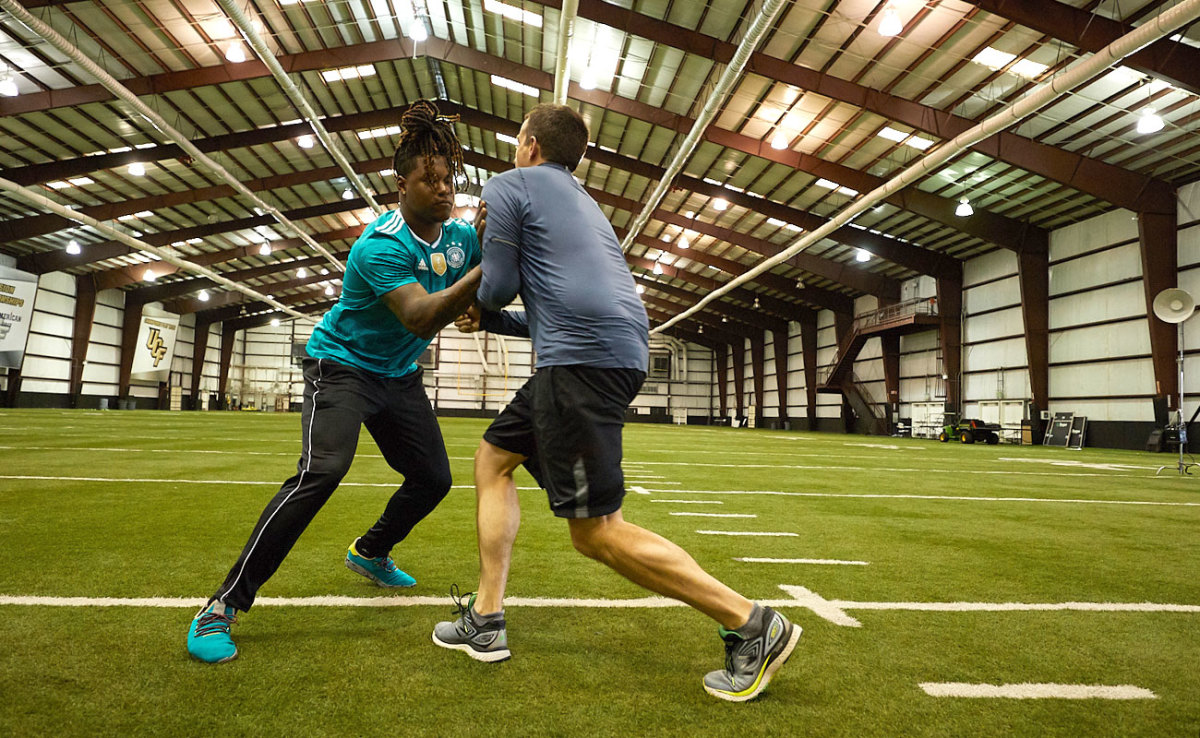
“Say we’re doing bag drills—you gotta be quick. On the first move you’ve gotta be able to stab,” he explains. “It’s all in one motion, so I come inside, stab, pull and you keep moving depending on where I need to go.”
I ask what happens if I try to reach block him to my right, towards his left arm. “Then I come inside,” he answered, “stab and pull.” And he’s standing in the hole, and I’ve overrun him.
This goes on for a good 20 minutes. He has an answer for everything, and it’s not just I’d crush this 38-year-old sports reporter. (Which he would, of course). More so, he’s putting on display how he’s taught himself to become a technician.
This brings up a phone call I had with one vice president from an AFC team, which I made just before this trip to Florida. I asked how Griffin makes it work. The VP said the one thing you have to remember is that this isn’t like a player breaking his hand and suddenly having to learn to play with a clublike cast—something that happens plenty at different levels of football—and without the use of a hand.
Instead, this has always been Griffin’s reality, and he’s found a way to turn it, in certain respects, into his edge. It shows in how opponents have tried to take advantage of the fact that he doesn’t have a left hand.
“You got some O-linemen, they wanna crash down, I’ll get to the back of their helmet and put their face in their dirt,” Griffin says, swiping his left arm over my head and using his right hand to push me down. “If they come with their head down, it’s easy to put my hand down and move forward. That’s a waste of a body now. You try to be overly aggressive, then that’s your fault.
“They’ll see me and say, ‘I’ll overpower him,’ and they come with their head down. Soon as they put their head down, I swipe in and they fall over—usually, fat guys fall over soon as you start pushing forward.”
What about in the open field? Running backs, Griffin says, will try to shake him and bounce plays going to the right boundary, toward his left shoulder, and cut back plays to the left sideline with the same idea in mind. So when I take the ball right, he presses his right shoulder towards me, using the sideline for leverage, and hooks my left leg. I go right, and he uses the boundary similarly, and plans to go in with a rugby tackle.
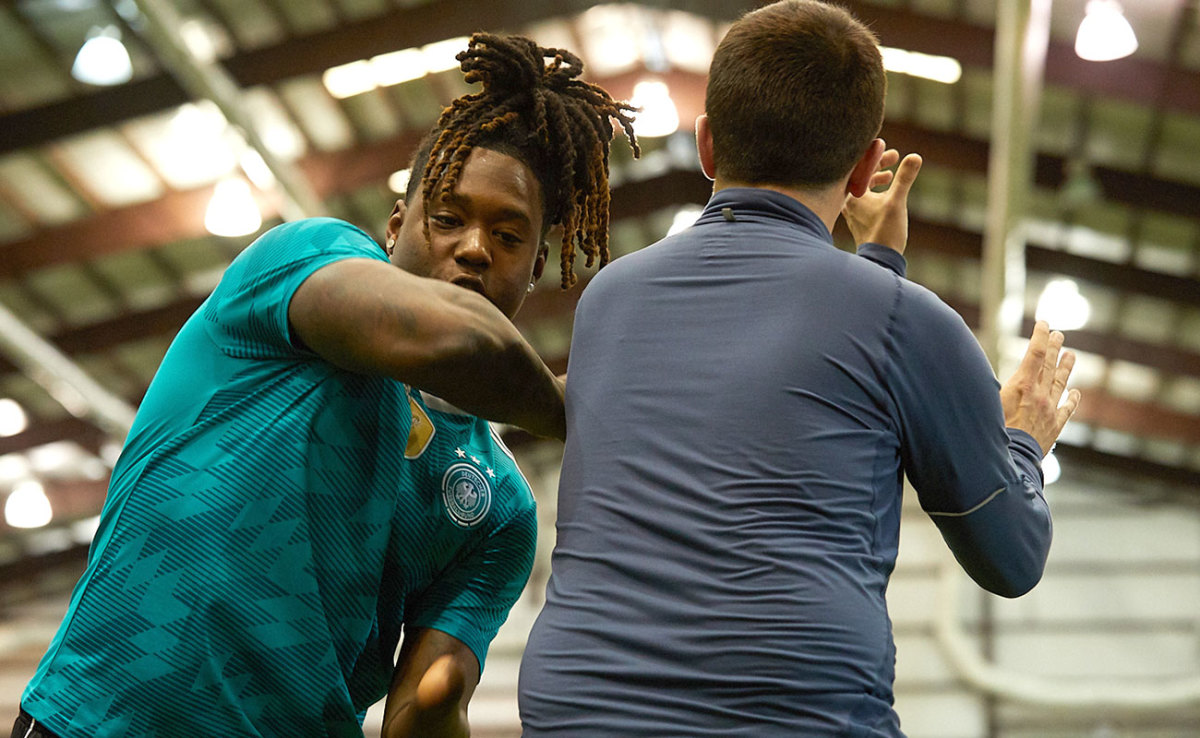
That’s if it’s one-on-one. If it’s not, he knows where his help is.
“So if I’m right here, I’ve got a safety that’s coming straight for you, and I’m inside of you, and I’ve got my corner to the outside,” he says. “It’s all about leverage—I’m coming in long stride, then short stride right here. So once I shoot, I get my shoulder on your hip, wrap you and then roll. Once I locked it, there ain’t much you can do. You can fight it and get your ACL torn, or you can just go with the roll.”
That answers, to a reasonable degree, one question NFL people gave me on how he’d make it work at their level: Can he take down bigger backs? Others asked about how he’d be able to block on punt team or kickoff return. And as we saw earlier, he had an answer for that one, too. He knows where his help is, and can influence guys to overrun the punter or returner if he needs to.
I loved the way one personnel man put it to me on Griffin: When so many talented kids were out there looking for reasons to not do the work, Shaquem was literally inventing ways TO do the work.
Everyone saw it at the combine, when Griffin churned out 20 reps of 225 pounds on the bench press with the help of a prosthetic on his left arm. That performance was a product of the days Griffin spent with his father in the family garage, creating apparatuses that would allow him to train the same any other kid could to play football, which becomes part of this story, too.
Fighting through a shortcoming is one thing. Having a plan for coming out on the other side of the story is just as important. Clearly, Griffin’s always had a plan, whether it was lifting in the garage or fighting off a scholarship guard at the point of attack.
As he explains, that much becomes obvious once coaches, teammates and opponents, who’ve doubted him initially on every level he’s played at, get him on to the grass: “Once I start putting hats on people, I start changing minds, quickly.”
For UCF tight end Jordan Akins, such a moment came when Griffin batted away a ball headed his way during practice with his left arm. “I already knew he was strong, he was physical,” says Akins. “You figure out he can play with anyone.” UCF corner and likely first-round pick Mike Hughes saw it off the field with Griffin. “In the weight room, there were some things he couldn’t do,” Hughes says, “but with the things he could do, he made up for it.”
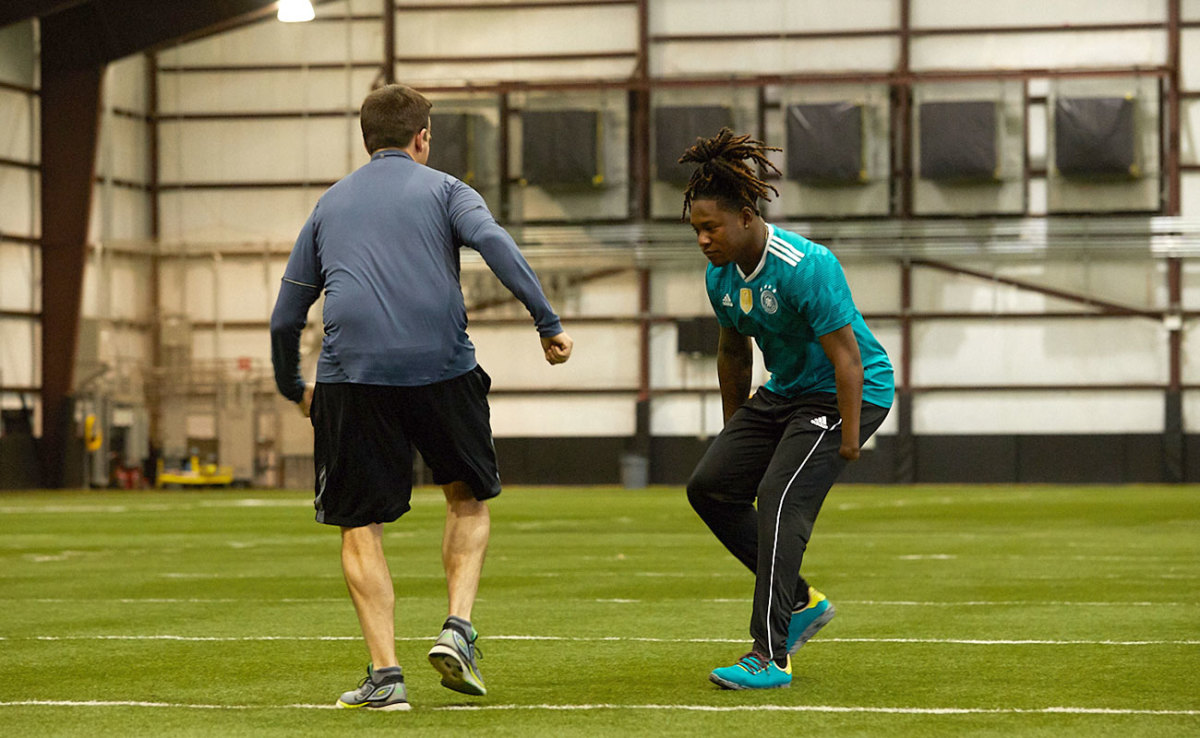
These things aren’t just a result of desire. There’s design to it.
That doesn’t mean there isn’t anything that’s a problem. The element that’s always been toughest for Griffin is the obvious one: catching the ball. “I got hit the face a few times before I learned,” he says. “My dad always said I’d learn to stop the ball from hitting me in the face. He was right about that. I did, man.”
It’s still not perfect. And the reaction when he drops a ball serves as a reminder that he can’t make excuses for himself, because they’ll be used against him by others.
“You see other guys who can’t catch the ball, they drop it, it doesn’t really matter,” Griffin says. “I drop the ball, it’s because of this or it’s because of that. It’s that next excuse—you don’t want to give me a shot because I’m dropping the ball. I was at the combine, you see all these linebackers dropping the ball. But I drop one and it’s, ‘Oh wow, why is he dropping the ball?’ ”

Griffin showed me how he’s learned to trap the ball. We threw a few, and he caught them clean. He’d dropped a couple about 24 hours earlier at his pro day, and it wasn’t the only moment where his left arm came into play.
In his first shot at the three-cone drill, he’d missed touching the line with his left arm and thus the guys running the drill said it would be hard for them to log the time as an accurate comp to the other UCF players’ results. So Griffin said he’d just run it again. And according to two of the scouts working stopwatches there, his second run, during which he hit all the lines he needed to, was better than the first.
That result, if you follow Griffin’s story, has become predictable. But it doesn’t happen just because he badly wants it to—he’s clearly always had that, back to the day after his surgery when his mom spotted him cradling a football in his right hand as a bandage off his left dripped blood.
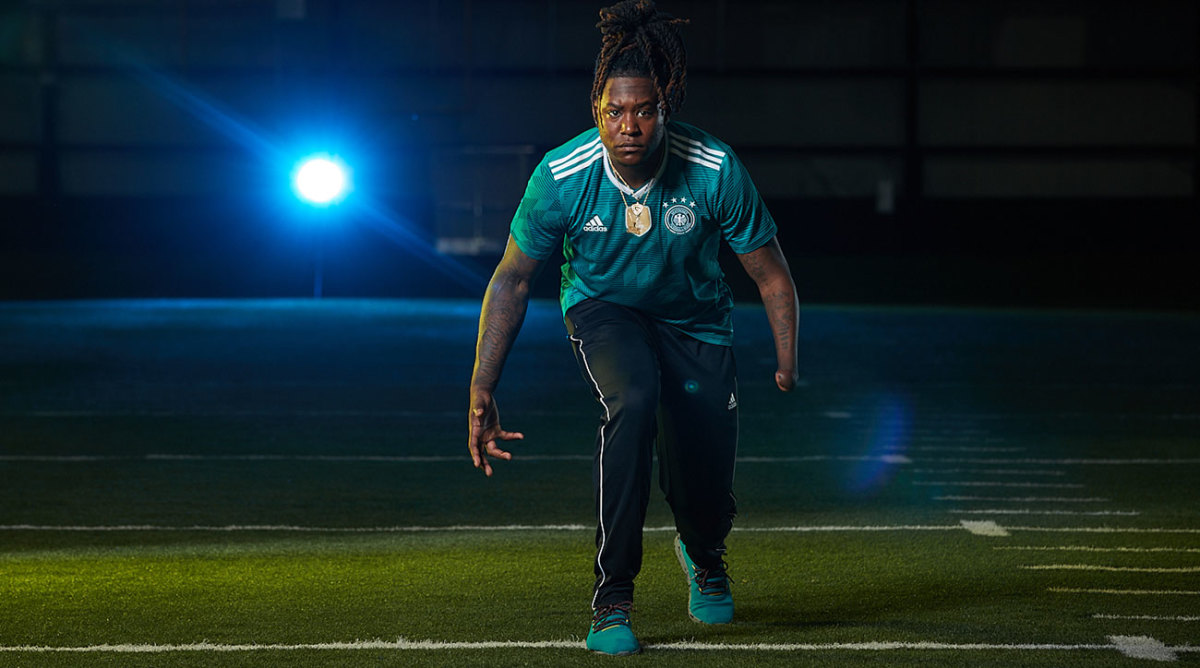
Griffin needed to have a plan, too, for how he’d be able to work within the context of the game he loved. And if I learned one thing down in Orlando, it’s that he most certainly has one.
Introducing SPORTS ILLUSTRATED TV, your new home for classic sports movies, award-winning documentaries, original sports programming and features, including Andy Staples’s profile of inspirational UCF linebacker Shaquem Griffin. Start your seven-day free trial of SI TV now on Amazon Channels.
Question or comment? Email us at talkback@themmqb.com.
